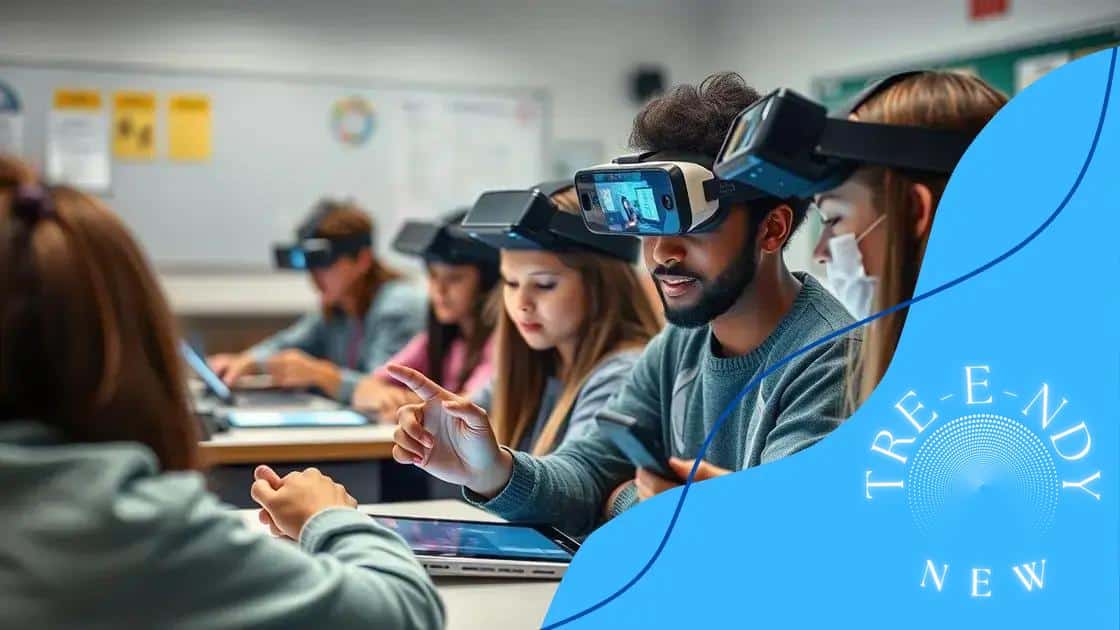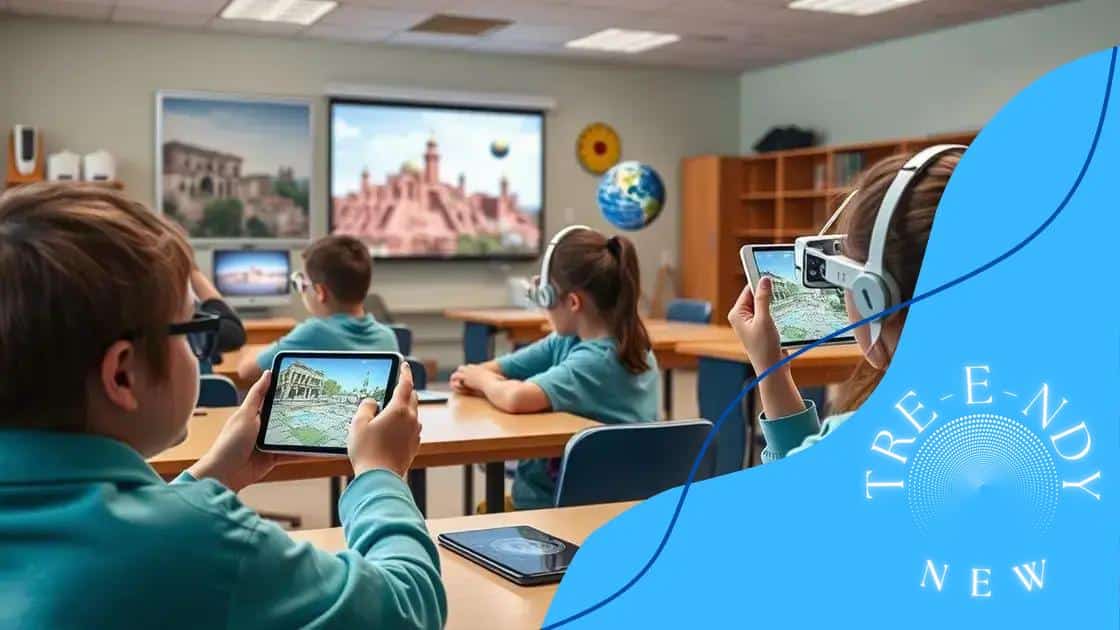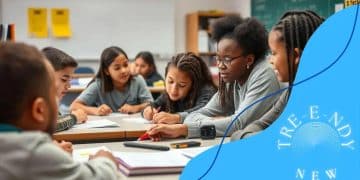How AR is being used for hands-on learning experiences

Augmented Reality (AR) enhances hands-on learning experiences by making education interactive, engaging, and personalized, allowing students to visualize and grasp complex concepts effectively.
How AR is being used for hands-on learning experiences is a game-changer in education. Imagine students exploring complex concepts through interactive visuals. Curious about how this works? Let’s dive in!
Understanding augmented reality in education
Understanding how augmented reality (AR) is reshaping education opens exciting possibilities. It is a technology that overlays digital information onto the real world, enhancing the learning experience. With this powerful tool, students can interact with 3D models and simulations, making complex ideas easier to grasp.
The Role of AR in the Classroom
Incorporating AR into education can increase student engagement. By transforming traditional learning into immersive experiences, students feel more involved. This technology allows learners to visualize concepts that might otherwise be too abstract.
Key Benefits of Using AR
- Interactive Learning: AR facilitates hands-on experiences, making learning more dynamic.
- Enhanced Retention: Students tend to remember information better when they can see and interact with it.
- Accessible Learning: Learners can engage with materials at their own pace, accommodating different learning styles.
For example, a student studying anatomy can use an AR app to see a 3D model of the human body, enabling them to understand the spatial relationships between organs. Such experiences enrich learning by providing context and clarity.
AR also breaks down barriers in education. Students in remote locations can access interactive content that enriches their learning experience without needing physical resources. This accessibility promotes inclusivity in education.
As AR technology evolves, teachers are finding new ways to implement these tools. They are using AR for various subjects, from math to history. This versatility makes AR a vital component of modern education.
Benefits of AR for hands-on learning
The benefits of AR for hands-on learning experiences are significant. By utilizing augmented reality, students can interact directly with digital content, building a deeper understanding of complex subjects. This technology encourages students to engage actively rather than passively consuming information.
Engagement and Motivation
When students use AR, they often find learning more exciting and enjoyable. This heightened engagement leads to improved motivation and may even foster a love for learning that lasts a lifetime. By incorporating fun and interactive elements into lessons, teachers can capture their students’ attention more effectively.
Enhanced Understanding
- Visualization: AR helps students visualize strong concepts that are hard to grasp through traditional methods.
- Real-World Application: It bridges the gap between theoretical knowledge and practical application, helping students understand how their lessons apply outside the classroom.
- Personalized Learning: Each learner can explore at their own pace, which is crucial for mastering complex topics.
For instance, in science classes, students can see chemical reactions in real-time, enhancing their understanding of the subject matter. This interactive approach to learning also allows for immediate feedback, letting students correct their mistakes and reinforcing what they’ve learned.
Furthermore, AR cultivates a collaborative environment where students work together to solve problems and engage in discussions. This collaboration not only improves social skills, but also facilitates peer-to-peer learning. Students can benefit from the diverse perspectives and strengths of their classmates, leading to a richer educational experience.
Ultimately, incorporating AR into hands-on learning can transform education, making it more accessible and impactful for students of all backgrounds. As technology continues to evolve, the potential for AR to enrich education will only grow, leading to a more innovative learning landscape.
Real-world applications of AR in classrooms

Real-world applications of AR in classrooms showcase the incredible potential of this technology in enhancing education. Educators are increasingly turning to augmented reality to create immersive and engaging lessons that captivate students’ attention.
Interactive Learning Experiences
One prominent example of AR’s impact is in science education. Students can use AR applications to explore the solar system, walking around 3D representations of planets and understanding their characteristics. This kind of interactive learning helps students visualize concepts that are otherwise difficult to grasp.
History Comes Alive
- AR History Apps: Students can witness historical events or figure out life in ancient civilizations through AR.
- Virtual Field Trips: Schools can take students on virtual tours of famous landmarks, enhancing their understanding of history.
- Engagement with Art: Art classes can utilize AR to bring famous paintings to life, showing the artist’s techniques and stories behind the artwork.
In languages, AR can be beneficial by providing real-time translations of signs or text in foreign languages. This practical application aids students in understanding how languages are used in everyday life, promoting a more profound appreciation for linguistic diversity.
Math can also benefit from AR, where students can manipulate 3D shapes to understand geometry concepts better. By interacting with these objects, students can grasp the volume and surface area in a way that is fun and informative. This hands-on approach to math ensures that students are not just memorizing formulas but truly understanding the material.
Another exciting application lies in vocational training. Students can use AR to practice complex skills like surgery or machinery operation in a safe environment. This not only prepares them for real-world situations but also enhances their confidence and competency in their chosen fields.
As educators increasingly integrate AR into their teaching strategies, the possibilities for innovation in the classroom will continue to grow. This technology not only makes learning more exciting but also bridges the gap between theoretical knowledge and practical application.
Challenges of implementing AR in education
Implementing AR in education presents several challenges, despite its many benefits. Understanding these hurdles is crucial for educators and institutions looking to adopt this technology.
Technical Barriers
One of the primary challenges is the technical requirements needed to effectively use augmented reality. Schools may lack the necessary equipment, such as tablets or AR glasses. Additionally, maintaining and updating software can strain limited budgets.
Teacher Training
- Professional Development: Many teachers may not be familiar with AR technology and will need proper training to implement it successfully.
- Time Constraints: With a busy curriculum, finding time to learn new technologies can be difficult for educators.
- Support Resources: Access to supportive resources or mentors can also be limited, making it challenging for teachers to feel confident in using AR.
Another significant challenge is the integration of AR into existing curricula. Educators often struggle to find suitable ways to blend AR into lesson plans that already have a tight structure. This requires thoughtful planning and sometimes the redesigning of entire units to include AR activities.
Moreover, there are concerns about accessibility. Not all students have equal access to the required technology at home or even in classrooms. This digital divide can lead to inequities in learning opportunities, as some students may benefit immensely from AR while others might not have the same experiences.
Furthermore, it’s essential to consider the potential for distraction. With many interactive elements, some students might struggle to stay focused on educational content. Teachers must find effective ways to manage and guide student engagement within AR environments to prevent this.
As schools navigate these challenges, it becomes evident that while the road to implementing AR in education is not without obstacles, the rewards can be worth the effort. Successful implementation takes careful planning, support for teachers, and a commitment to providing equitable access for all students.
The future of AR in educational experiences
The future of AR in educational experiences is both promising and exciting. As technology advances, augmented reality is expected to play an even larger role in how students learn and engage with material.
Innovative Learning Environments
One major trend is the creation of immersive learning environments. Schools are beginning to integrate AR into the classroom to create experiences that are more interactive and engaging. By using AR, lessons can be transformed into rich, multisensory experiences that capture students’ attention.
Personalized Education
- Tailored Learning: As AR becomes more widespread, it is likely that personalized learning experiences will evolve. Students can work at their own pace, with AR guiding them through customized lessons that meet their needs.
- Adaptive Content: With the use of analytics, AR can adapt in real-time to provide challenges or assistance based on a student’s performance.
- Diverse Learning Styles: AR caters to various learning styles, allowing visual, auditory, and kinesthetic learners to benefit from the same educational tools.
Moreover, the rise of virtual and mixed reality in education is likely. These technologies will enable students to explore realistic simulations, from historical events to scientific experiments, in ways that textbooks simply cannot provide. Imagine a history lesson where students “walk” through ancient ruins or a biology class where they can dissect virtual organisms.
Additionally, collaborating on projects using AR tools encourages teamwork among students. As they solve problems together in a shared augmented space, they develop important social skills while learning. This collaboration will be integral in preparing students for real-world interactions.
Furthermore, teacher training programs are increasingly including AR technology. Future educators will learn how to leverage AR in their teaching approaches, ensuring that they are well-prepared to embrace these emerging technologies in the classroom.
Overall, the future of AR in education is set to transform how students learn, making it more interactive, personalized, and collaborative. As schools and educators continue to adapt to these advancements, students will undoubtedly benefit from enhanced learning experiences.
As augmented reality continues to evolve, it brings exciting possibilities for education. It enhances learning by making it interactive and engaging, helping students grasp complex concepts. The challenges of implementing AR are real, but with thoughtful planning and support, schools can overcome them. By investing in technology and training, educators can transform classrooms into dynamic spaces where students thrive. As we look to the future, AR will play a crucial role in revolutionizing educational experiences, preparing students for a vibrant world full of opportunities.
FAQ – Frequently Asked Questions about Augmented Reality in Education
How does AR enhance student engagement?
AR makes learning interactive and fun, allowing students to explore subjects in an immersive way that captures their attention.
What are the main challenges of implementing AR in classrooms?
Challenges include the need for proper equipment, teacher training, and ensuring all students have access to the technology.
Can AR be personalized for individual learning styles?
Yes, AR can adapt content to suit different learning styles, helping each student learn in a way that works best for them.
What is the future potential of AR in education?
The future of AR in education looks bright, with advancements expected to create even more engaging and effective learning experiences.





